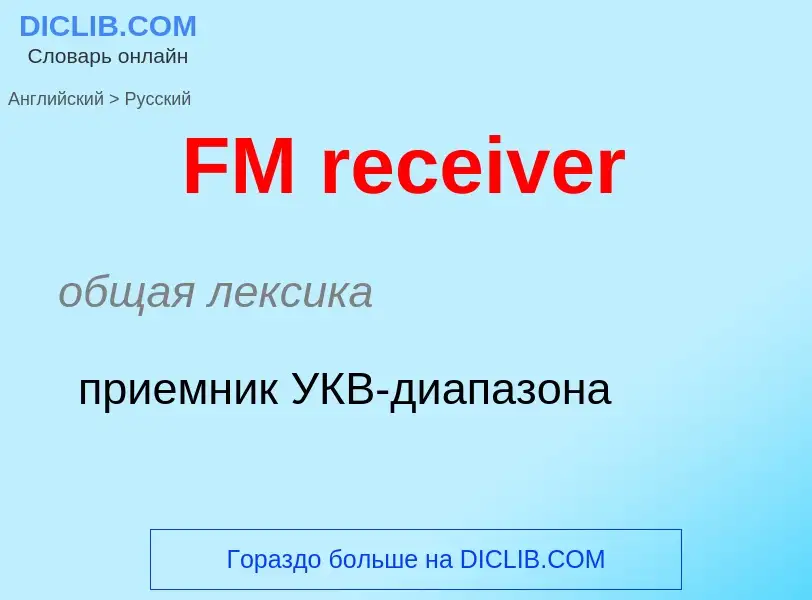Μετάφραση και ανάλυση λέξεων από την τεχνητή νοημοσύνη ChatGPT
Σε αυτήν τη σελίδα μπορείτε να λάβετε μια λεπτομερή ανάλυση μιας λέξης ή μιας φράσης, η οποία δημιουργήθηκε χρησιμοποιώντας το ChatGPT, την καλύτερη τεχνολογία τεχνητής νοημοσύνης μέχρι σήμερα:
- πώς χρησιμοποιείται η λέξη
- συχνότητα χρήσης
- χρησιμοποιείται πιο συχνά στον προφορικό ή γραπτό λόγο
- επιλογές μετάφρασης λέξεων
- παραδείγματα χρήσης (πολλές φράσεις με μετάφραση)
- ετυμολογία
FM receiver - translation to ρωσικά
общая лексика
приемник УКВ-диапазона
[reidiəuri'si:və]
общая лексика
приёмная радиостанция
радиоприёмник
радиоприемное устройство
Ορισμός
Βικιπαίδεια

In firearms terminology, the firearm frame or receiver is the part of a firearm which integrates other components by providing housing for internal action components such as the hammer, bolt or breechblock, firing pin and extractor, and has threaded interfaces for externally attaching ("receiving") components such as the barrel, stock, trigger mechanism and iron/optical sights.
The receiver is often made of forged, machined, or stamped steel or aluminium. In addition to these traditional materials, modern science and engineering have introduced polymers and sintered metal powders to receiver construction.


![[[AR-15]] rifles showing their configurations with different upper receivers. The lower receiver is visible at the bottom [[AR-15]] rifles showing their configurations with different upper receivers. The lower receiver is visible at the bottom](https://commons.wikimedia.org/wiki/Special:FilePath/Stag2wi.jpg?width=200)
.jpg?width=200)


![[[Guglielmo Marconi]], who built the first radio receivers, with his early spark transmitter ''(right)'' and coherer receiver ''(left)'' from the 1890s. The receiver records the Morse code on paper tape [[Guglielmo Marconi]], who built the first radio receivers, with his early spark transmitter ''(right)'' and coherer receiver ''(left)'' from the 1890s. The receiver records the Morse code on paper tape](https://commons.wikimedia.org/wiki/Special:FilePath/Guglielmo Marconi 1901 wireless signal.jpg?width=200)
.jpg?width=200)

![A modern [[communications receiver]], used in [[two-way radio]] communication stations to talk with remote locations by [[shortwave radio]]. A modern [[communications receiver]], used in [[two-way radio]] communication stations to talk with remote locations by [[shortwave radio]].](https://commons.wikimedia.org/wiki/Special:FilePath/Icom IC-R7000 radio receiver.jpg?width=200)
![A galena cat's whisker detector from a 1920s [[crystal radio]] A galena cat's whisker detector from a 1920s [[crystal radio]]](https://commons.wikimedia.org/wiki/Special:FilePath/Kristallradio (3).jpg?width=200)
![A bedside [[clock radio]] that combines a radio receiver with an [[alarm clock]] A bedside [[clock radio]] that combines a radio receiver with an [[alarm clock]]](https://commons.wikimedia.org/wiki/Special:FilePath/Radio-with-Alarm clock.jpg?width=200)

![Example of transatlantic radiotelegraph message recorded on paper tape by a [[siphon recorder]] at RCA's New York receiving center in 1920. The translation of the Morse code is given below the tape. Example of transatlantic radiotelegraph message recorded on paper tape by a [[siphon recorder]] at RCA's New York receiving center in 1920. The translation of the Morse code is given below the tape.](https://commons.wikimedia.org/wiki/Special:FilePath/Radiotelegraph syphon recorder tape 1922.png?width=200)

![During the "[[Golden Age of Radio]]" (1920 to 1950), families gathered to listen to the home radio in the evening, such as this Zenith console model 12-S-568 from 1938, a 12-tube superheterodyne with pushbutton tuning and 12-inch cone speaker. During the "[[Golden Age of Radio]]" (1920 to 1950), families gathered to listen to the home radio in the evening, such as this Zenith console model 12-S-568 from 1938, a 12-tube superheterodyne with pushbutton tuning and 12-inch cone speaker.](https://commons.wikimedia.org/wiki/Special:FilePath/Vintage Zenith Console Radio, Model 12S-568, With the Zenith Robot (or Shutter) Dial, Circa 1941 (8655513293).jpg?width=200)
.jpg?width=200)
